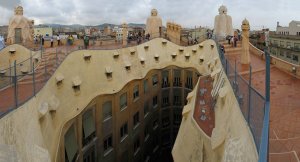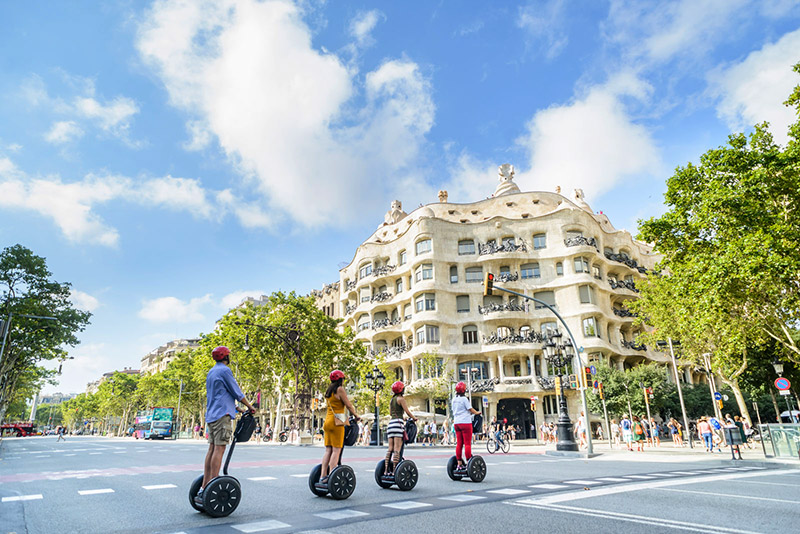Casa Milà, popularly known as La Pedrera or “The stone quarry”, a reference to its unconventional rough-hewn appearance, is a modernist building in Barcelona, Catalonia, Spain. It was the last private residence designed by architect Antoni Gaudí and was built between 1906 and 1912.
The building was commissioned in 1906 by Pere Milà and his wife Roser Segimon. At the time, it was controversial because of its undulating stone facade, twisting wrought iron balconies and designed by Josep Maria Jujol. Several structural innovations include a self-supporting stone façade, and a free-plan floor, underground garage and the spectacular on the roof-terrace.
In 1984, it was declared a World Heritage Site by UNESCO. From 2013 is the headquarters of the Fundació Catalunya La Pedrera which manages the visit to the building, exhibitions and other cultural and educative activities at Casa Milà.
Critics and controversies
The building did not respect any rules of conventional style, for which Gaudí received much criticism. To begin with, the name “La Pedrera” is in fact a nickname assigned by the citizens who disapproved of its unusualness. The unique structure of the building and the relationship between the building’s architect and Pere Milà became the object of ridicule for the people of Barcelona and many humorous publications of the time.
Catholic symbols
A fragment from first drafts of the architectural plans from 1906, showing the sculptures mounted on the upper facade.
Gaudí, a Catholic and a devotee of the Virgin Mary, planned for the Casa Milà to be a spiritual symbol. Overt religious elements include an excerpt from the Rosary on the cornice and planned statues of Mary, specifically Our Lady of the Rosary, and two archangels, St. Michael and St. Gabriel.
However, the Casa Milà was not built entirely to Gaudí’s specifications. The local government ordered the demolition of elements that exceeded the height standard for the city, and fined the Milàs for many infractions of building codes. After Semana Trágica, an outbreak of anticlericalism in the city, Milà prudently decided to forgo the religious statues. Gaudí contemplated abandoning the project but a priest persuaded him to continue.
Restoration
After being re-painted a dreary brown, the building’s colors were restored in the 1980s
Gaudí’s work was designated a historic and artistic monument on July 24, 1969. Casa Milà was in poor condition in the early 1980s. It had been painted a dreary brown and many of its interior color schemes had been abandoned or allowed to deteriorate, but it has been restored since and many of the original colors revived.[
In 1984 the building became part of a World Heritage Site encompassing some of Gaudí’s works. The Barcelonan city council tried to rent the main floor as an office for the 1992 Olympic bid. Finally, the day before Christmas 1986, Caixa Catalunya bought La Pedrera for 900 million pesetas.[citation needed] On February 19, 1987, urgently needed work began on the restoration and cleaning of the façade. The work was done by the architects Joseph Emilio Hernández-Cross and Rafael Vila.[citation needed] The renovated main floor opened in 1990 as part of the Cultural Olympiad of Barcelona. The floor became an exhibition room with an example of modernism in the Eixample.
Design
The building is 1,323 m2 per floor on a plot of 1,620 m2. Gaudí made the first sketches in his workshop in the Sagrada Família. He designed the house as a constant curve, both outside and inside, incorporating ruled geometry and naturalistic elements.
The courtyard
 Casa Milà consists of two buildings, which are structured around two courtyards that provide light to the nine storeys: basement, ground floor, mezzanine, main (or noble) floor, four upper floors, and an attic. The basement was intended to be the garage, the main floor the residence of the Milàs (a flat of all 1,323 m2), and the rest distributed over 20 apartments. The resulting layout is shaped like an asymmetrical “8” because of the different shapes and sizes of the courtyards. The attic housed the laundry and drying areas, forming an insulating space for the building and simultaneously determining the levels of the roof.
Casa Milà consists of two buildings, which are structured around two courtyards that provide light to the nine storeys: basement, ground floor, mezzanine, main (or noble) floor, four upper floors, and an attic. The basement was intended to be the garage, the main floor the residence of the Milàs (a flat of all 1,323 m2), and the rest distributed over 20 apartments. The resulting layout is shaped like an asymmetrical “8” because of the different shapes and sizes of the courtyards. The attic housed the laundry and drying areas, forming an insulating space for the building and simultaneously determining the levels of the roof.
One of the most notable elements of the building is the roof, crowned with skylights, staircase exits, fans, and chimneys. All of these elements, constructed out of brick covered with lime, broken marble, or glass have a specific architectural function but are also real sculptures integrated into the building.
The apartments feature plastered ceilings with dynamic reliefs, handcrafted wooden doors, windows, and furniture, as well as hydraulic tiles and various ornamental elements.
The stairways were intended as service entries, with the main access to the apartments by elevator except for the noble floor, where Gaudí added a prominent interior staircase. Gaudí wanted the people who lived in the flats to all know each other. Therefore, there were only elevators on every other floor, so people on different floors would meet one another.
Structure
CasaMila-Balcony, showing the self-supporting stone facade, also supported by curved iron beams
Casa Milà is characterized by its self-supporting stone facade, meaning that it is free of load-bearing walls. The facade connects to the internal structure of each floor by means of curved iron beams surrounding the perimeter of each floor. This construction system allows, on one hand, large openings in the facade which give light to the homes, and on the other, free structuring of the different levels, so that internal walls can be added and demolished without affecting the stability of the building. This allows the owners to change their minds at will and to modify, without problems, the interior layout of the homes.
Constructive and decorative items
Facade
The facade is composed of large blocks of limestone from the Garraf Massif on the first floor and from the Villefranche quarry for the higher levels. The blocks were cut to follow the plot of the projection of the model, then raised to their location and adjusted to align in a continuous curve to the pieces around them.
Viewed from the outside the building has three parts: the main body of the six-storey blocks with winding stone floors, two floors set a block back with a different curve, similar to waves, a smoother texture and whiter color, and with small holes that look like embrasures, and finally the body of the roof.
Gaudí’s original facade had some of its lower-level ironwork removed. In 1928, the tailor Mosella opened the first store in La Pedrera, and he eliminated the bars. This did not concern anyone, because in the middle of twentieth century, wrought ironwork had little importance. The ironwork was lost until a few years later, when Americans donated one of them to the MoMa, where it is on display.
With restoration initiatives launched in 1987, the facade was rejoined to some pieces of stone that had fallen. In order to respect the fidelity of the original, material was obtained from the Villefranche quarry, even though by then it was no longer operating.
Hall and courtyards
The building uses a completely original solution to solve the issue of a lobby being too closed and dark. Its open and airy courtyards provide a place of transit and are directly visible to those accessing the building. There are two patios on the side of the Passeig de Gracia and of the street Provence.
Patios
The patio
Patios, structurally, are key as supporting loads of interior facades. The floor of the courtyard is supported by pillars of cast iron. In the courtyard, there are traditional elliptical beams and girders but Gaudí applied an ingenious solution of using two concentric cylindrical beams with stretched radial beams, like the spokes of a bicycle. They form a point outside of the beam to two points above and below, making the function of the central girder a keystone and working in tension and compression simultaneously. This supported structure is twelve feet in diameter and is considered “the soul of the building” with a clear resemblance to Gothic crypts. The centerpiece was built in a shipyard by Josep Maria Carandell who copied a steering wheel, interpreting Gaudí’s intent as to represent the helm of the ship of life.
Interior, gates
Paintings cover the walls, with access protected by a giant iron gate
Access is protected by a massive iron gate with a design attributed to Jujol. It was originally used by both people and cars, as access to the garage is in the basement, now an auditorium.
The two halls are fully polychrome with oil paintings on the plaster surfaces, with eclectic references to mythology and flowers.
During construction there was a problem including a basement as a garage for cars, the new invention that was thrilling the bourgeois at the time. The future neighbor Felix Anthony Meadows, owner of Industrial Linera, requested a change because his Rolls Royce could not access it. Gaudí agreed to remove a pillar on the ramp that led into the garage so that Felix, who was establishing sales and factory in Walls of Valles, could go to both places with his car from La Pedrera.
For the floors of Casa Milà, Gaudí used a model of floor forms of square timbers with two colors, and the hydraulic pavement hexagonal pieces of blue and sea motifs that had originally been designed for the Batllo house. The wax was designed in gray by John Bertrand under the supervision of Gaudí who “touched up with their own fingers,” in the words of the manufacturer Josep Bay.
Loft
The attic
Like in Casa Batlló, Gaudí shows the application of the catenary arch as a support structure for the roof, a form which he had already used shortly after graduating in the wood frameworks of Mataró’s cooperative known as “L’Obrera Mataronense.” In this case, Gaudí used the Catalan technique of timbrel, imported from Italy in the fourteenth century.
The attic, where the laundry rooms were located, was a clear room under a Catalan vault roof supported by 270 parabolic vaults of different heights and spaced by about 80 cm. The roof resembles both the ribs of a huge animal and a palm, giving the roof-deck a very unconventional shape similar to a landscape of hills and valleys. The shape and location of the courtyards makes the arches higher when the space is narrowed and lower when the space expands.
The builder Bayó explained its construction: “First the face of a wide wall was filled with mortar and plastered. Then Canaleta indicated the opening of each arch and Bayó put a nail at each starting point of the arch at the top of the wall. From these nails was dangled a chain so that the lowest point coincided with the deflection of the arch. Then the profile displayed on the wall by the chain was drawn and on this profile the carpenter marked and placed the corresponding centering, and the timbrel vault was started with three rows of plane bricks. Gaudí wanted to add a longitudinal axis of bricks connecting all vaults at their keystones”.
Roof and chimneys
Casa Milà roof architecture, chimneys known as espanta bruixes (witch scarers)
The work of Gaudí on the rooftop of La Pedrera brought his experience at Palau Güell together with solutions that were clearly more innovative – this time creating shapes and volumes with more body, more prominence, and less polychromasia. <Permanyer, either 1996 or 2008>
On the rooftop there are six skylights/staircase exits (four of which were covered with broken pottery and some that ended in a double cross typical of Gaudí), twenty-eight chimneys in several groupings, two half-hidden vents whose function is to renew the air in the building, and four domes that discharged to the facade. The staircases also house the water tanks; some of which are snail-shaped.
The stepped roof of La Pedrera, called “the garden of warriors” by the poet Pere Gimferrer because the chimneys appear to be protecting the skylights, has undergone a radical restoration, removing chimneys added in interventions after Gaudí, television antennas, and other elements that degraded the space. The restoration brought back the splendor to the chimneys and the skylights that were covered with fragments of marble and broken Valencia tiles. One of the chimneys was topped with glass pieces – it was said that Gaudí did that the day after the inauguration of the building, taking advantage of the empty bottles from the party. It was restored with the bases of champagne bottles from the early twentieth century. The repair work has enabled the restoration of the original impact of the overhangs made of stone from Ulldecona with fragments of tiles. This whole set is more colorful than the facade, although here the creamy tones are dominant.
Schedules: 10:00-12:30-14:30-17:00
Price: € 59
Contact us for personalized schedules.
Entrance fees to the monuments are not included.














